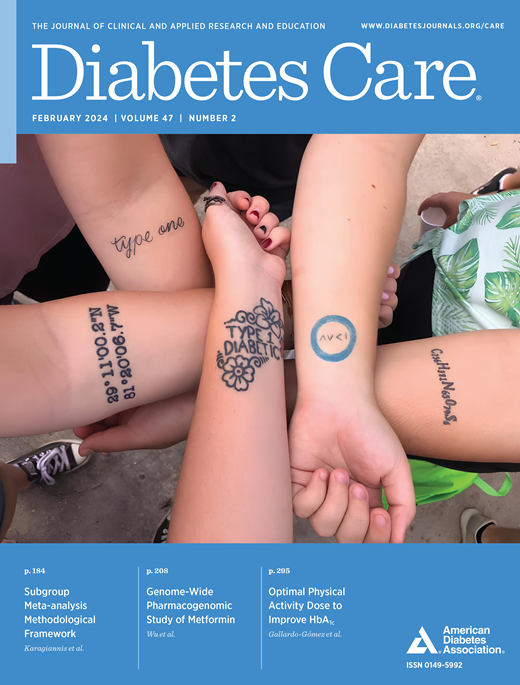采用 KDIGO 分类的 1 型糖尿病患者不良后果的负担和过高风险:一项全国队列研究
IF 14.8
1区 医学
Q1 ENDOCRINOLOGY & METABOLISM
引用次数: 0
摘要
目的 广泛采用的肾脏疾病:改善全球预后(KDIGO)分类系统在评估 1 型糖尿病不良预后的负担和风险方面一直未得到充分利用。本观察性研究旨在阐明 KDIGO 各分类与该患者群体的预后(包括死亡率)之间的相关性。研究设计与方法 在瑞典国家糖尿病登记处的 40199 名 1 型糖尿病患者中,我们研究了 1) 基线时不同 KDIGO 类别的患病率;2) 每个类别中不良肾脏和心血管 (CV) 结果(包括死亡率)的发生率;3) 基线类别与五种结果的超额风险之间的关系:估计肾小球滤过率(eGFR)下降 40%、肾衰竭、主要肾脏/心血管不良事件和全因死亡率。采用三种不同的参考类别进行了 Cox 回归分析:1)传统的低风险 "合并 G1A1 + G2A1";2)单独的 "G1A1",以评估 G2A1 是否具有超额风险;3)单独的 "G1bA1",以评估 eGFR≥105 mL/min/1.73 m2 是否会增加风险。结果 在平均随访 9.1 年的 39067 名纳入患者中,18.5% 的患者患有慢性肾脏病(CKD),其定义为 eGFR <60 mL/min/1.73 m2 和/或白蛋白尿。随着 eGFR 和白蛋白尿类别的增加,包括在 G2A1(非 CKD)中,所有研究结果的发生率和调整后危险比都逐渐增加。肾小球滤过率≥105 mL/min/1.73 m2且无白蛋白尿与风险增加无关。结论 随着 KDIGO 类别的增加,所研究的所有不良后果的负担都会逐渐增加。即使是 eGFR 保持不变且有正常白蛋白尿(G2A1)的人(传统上被认为是非 CKD 患者),其所有不良后果的风险也会增加。本文章由计算机程序翻译,如有差异,请以英文原文为准。
Burden and Excess Risk of Adverse Outcomes in Patients With Type 1 Diabetes Using KDIGO Classification: A National Cohort Study
OBJECTIVE The widely adopted Kidney Disease: Improving Global Outcomes (KDIGO) classification system has been underused in assessing the burden and risk of adverse outcomes in type 1 diabetes. This observational study aimed to clarify how each KDIGO category correlates with outcomes, including mortality, in this patient group. RESEARCH DESIGN AND METHODS In 40,199 individuals with type 1 diabetes from the Swedish National Diabetes Register, we examined the 1) prevalence of different KDIGO categories at baseline; 2) incidence of adverse kidney and cardiovascular (CV) outcomes, including mortality, within each category; and 3) association of baseline category with excess risk of five outcomes: 40% decline in estimated glomerular filtration rate (eGFR), kidney failure, major adverse kidney/CV events, and all-cause mortality. Cox regression analyses were conducted using three different reference categories: 1) the conventional low-risk “combined G1A1 + G2A1”; 2) “G1A1” alone to assess whether G2A1 had excess risk; and 3) “G1bA1” alone to evaluate whether eGFR ≥105 mL/min/1.73 m2 had increased risk. RESULTS Among 39,067 included patients, with a mean follow-up of 9.1 years, 18.5% presented with chronic kidney disease (CKD), defined as eGFR <60 mL/min/1.73 m2 and/or albuminuria. A progressive increase in the incidence and adjusted hazard ratio for all studied outcomes was found with advancing eGFR and albuminuria categories, including in G2A1 (non-CKD). A eGFR ≥105 mL/min/1.73 m2 without albuminuria was not associated with increased risk. CONCLUSIONS A progressively increasing burden of all studied adverse outcomes was observed with advancing KDIGO categories. Even individuals with preserved eGFR and normoalbuminuria (G2A1) conventionally perceived as non-CKD, had an excess risk for all outcomes.
求助全文
通过发布文献求助,成功后即可免费获取论文全文。
去求助
来源期刊

Diabetes Care
医学-内分泌学与代谢
CiteScore
27.80
自引率
4.90%
发文量
449
审稿时长
1 months
期刊介绍:
The journal's overarching mission can be captured by the simple word "Care," reflecting its commitment to enhancing patient well-being. Diabetes Care aims to support better patient care by addressing the comprehensive needs of healthcare professionals dedicated to managing diabetes.
Diabetes Care serves as a valuable resource for healthcare practitioners, aiming to advance knowledge, foster research, and improve diabetes management. The journal publishes original research across various categories, including Clinical Care, Education, Nutrition, Psychosocial Research, Epidemiology, Health Services Research, Emerging Treatments and Technologies, Pathophysiology, Complications, and Cardiovascular and Metabolic Risk. Additionally, Diabetes Care features ADA statements, consensus reports, review articles, letters to the editor, and health/medical news, appealing to a diverse audience of physicians, researchers, psychologists, educators, and other healthcare professionals.
 求助内容:
求助内容: 应助结果提醒方式:
应助结果提醒方式:


